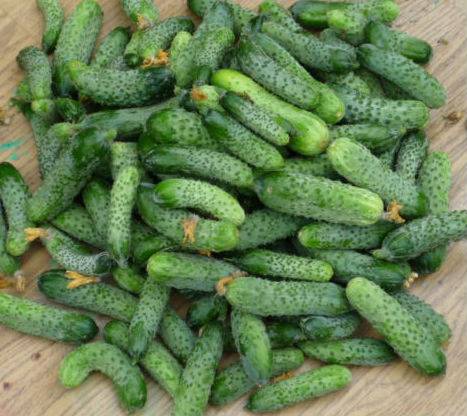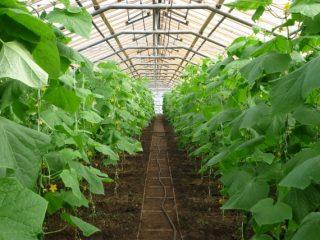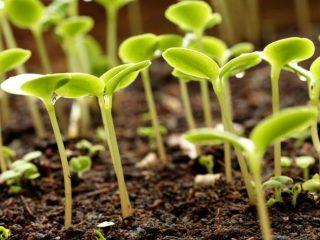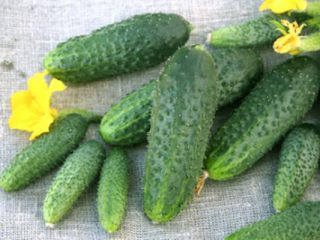Content
Almost all gardeners love to grow cucumbers. The culture is quite demanding in terms of conditions, but the unsurpassed taste of the vegetable outweighs the effort expended. Gherkins, small-fruited varieties of cucumbers, the main difference of which are the miniature fruits, have gained particular popularity.
The average length of cucumbers reaches 6-10 cm in length, the peel is thin, the flesh is dense without voids, and the seeds are small. They have an excellent taste, a pleasant crunch, which is appreciated by all lovers of lightly salted vegetables. Often, gherkins are replaced with ordinary varieties, plucking unripe small-sized fruits. However, the taste qualities of ordinary varieties of cucumbers are noticeably inferior to the little ones - gherkins.
Small-fruited cucumbers are grown both in open ground and in greenhouses. The second option allows you to get an earlier harvest, as well as protect vegetables from temperature changes and irregular moisture.
Features of growing small-fruited varieties of cucumbers
Gherkin cucumbers are whimsical agricultural technology. To get a good harvest you need:
- carefully dose mineral fertilizers;
- maintain optimal watering and lighting;
- keep the cucumber beds clean;
- loosen the soil frequently but carefully;
- delete in time weeds;
- regularly carry out measures against pests and diseases of cucumbers.
The main difference and guarantee of success when growing gherkins is the need for daily collection of fruits. This allows the bush to activate fruiting. Cucumbers do not outgrow and retain their taste and nutritional value. Fruit growth stops at a length of 10-11 cm, then intensive thickening begins. Overgrowth does not allow the rest of the cucumbers to fill up, and the yield decreases.
For small-fruited gherkin varieties, it is not recommended to use diffuse watering. Cucumber does not tolerate moisture on the leaves; it is better to moisten the soil in the root zone. The plant immediately signals a lack of moisture by wilting leaves, so regular watering is an important condition for a large harvest of gherkins when grown in greenhouses and in the ground.
To get the desired result, you must adhere to the basic recommendations for caring for gherkins. Open ground has its own specific characteristics. A greenhouse requires, in addition to knowledge of agrotechnical measures, to study the rules for operating greenhouses. This will make it possible to obtain an early and high-quality harvest of cucumbers. But the result will justify all the effort.
Useful tips for growing cucumbers in a greenhouse
Many people choose the method of growing cucumbers in a greenhouse. This allows not only to shorten the ripening period of fruits, but also to create more comfortable conditions for plants. First of all, you should take care of the cleanliness and ventilation of the greenhouse. Wooden greenhouse structures are disinfected, metal ones are painted.Before planting gherkin seedlings in the greenhouse, all measures are taken to disinfect the soil, remove plant residues, and arrange the beds.
Such actions are carried out in the fall after harvesting. The main activities in greenhouses that will have to be carried out during the period of growing cucumbers remain:
- watering;
- feeding;
- protection of cucumbers from diseases and pests.
Also, the yield directly depends on the choice of gherkin seeds.
In this case, there is no need for artificial pollination and pinching of gherkin lashes. When grown in a greenhouse, all self-pollinating cucumber varieties must be shaped to prevent excessive thickening.
This causes a decrease in yield and the appearance of common diseases on cucumbers - powdery mildew, stem rot. To avoid this, you need to cut off the ends of the lashes after the second leaf on the side shoots.
Basic recommendations
Even a novice gardener can get a good harvest of gherkins in a greenhouse. We follow certain rules and enjoy crispy cucumbers. Be sure to provide the plants with a sufficient amount of nutrients, light and moisture.
Preparing fertile soil
If you have already grown any vegetables in the greenhouse, then you need to prepare the soil for the next harvest in advance. Cucumbers love a high-quality mixture, so the soil in the greenhouse must be fertile. The optimal combination would be fresh humus with turf soil. A mixture of field soil, taken in an amount of 20% of the total volume, with the addition of 50% peat and 30% humus, has proven well.Preparing soil for a greenhouse is not difficult. After harvesting the crop and all plant residues, the soil is disinfected. Dig up all the beds of the greenhouse to the depth of a spade (20 cm) and treat the ground with a solution of copper sulfate (7%). A month later, prepare a soil mixture for cucumbers with the ratio of components described above. Nutrients are added and placed in greenhouse beds. For one cubic meter of volume, 2 kg is enough potassium sulfate, 3 kg of superphosphate, 0.4 kg of ammonium nitrate.
If the soil is prepared in the spring, then well-rotted manure that has undergone biothermal disinfection should be applied. The ridges are made after covering the greenhouse with film when the soil is ready. They are located either along or across the shelter. This depends on the size of the greenhouse.
During the period of growing cucumbers in a greenhouse, it is necessary to monitor soil compaction. Loosening is carried out regularly and carefully so as not to damage the root system of gherkin cucumbers, which is located close to the surface.
We carry out proper watering in the greenhouse
To obtain a stable harvest of cucumbers, you have to control soil moisture. Overmoistening is just as undesirable as moisture deficiency. In addition, regular watering is an important factor. With sharp fluctuations in soil moisture, cracking of the roots and the appearance of root rot occur. On hot days, gherkins are watered daily, on cloudy and cool days - as needed. The best time to water in a greenhouse is in the evening, when the water is warm enough.Cold water is very harmful to the root system of cucumbers. To avoid compacting the soil too much, put a regular sprinkler on the end of the hose or the spout of a watering can. Water is poured carefully, trying not to get on the leaves of the gherkins. After each watering, shallow loosening of the soil is carried out. If the roots of the cucumbers come to the surface, it is necessary to sprinkle the nutrient mixture in a layer of no more than one and a half centimeters.
Regular ventilation against diseases
The film covering of the greenhouse does not allow water vapor to pass through, so ventilation must be done every day. To do this, open only the upper windows, protecting the gherkins from drafts. Dry air creates favorable conditions in the greenhouse for cucumber pests (spider mites). It is very useful for cucumbers to carry out daily humidity control to avoid large changes.
Proper feeding is half the success
The ability to feed gherkins competently helps not only preserve, but also significantly increase the harvest. Over the entire season, it is enough to fertilize cucumbers four to five times, the main thing is to do it on time. There are two groups - organic and mineral fertilizers. They can be applied by root and foliar methods. Cucumber signals a deficiency of any element in a certain way. Basic requirements when applying fertilizers:
- Normalization. Any overdose is harmful, but a deficiency of nutrients will cause no less harm. In a greenhouse, one more rule must be followed. The ideal option is to feed the gherkins in small doses, following the recipe recommendations.
- High-quality composition. Cucumbers need minerals - nitrogen, phosphorus, potassium, as well as organic ones - mullein, chicken droppings.
- Application time.The first greenhouse feeding is carried out before the gherkins bloom. The next ones can be carried out no earlier than 14 days after the first. During the season, the optimal amount for cucumbers is three or four times.
- Type of fertilizer. Nitrogen is necessary for the full development of leaf mass, but reduces the quality of the fruit. Therefore, it is better to use fertilizers without nitrate nitrogen in the greenhouse. Phosphorus stimulates flowering and fruit set of cucumbers, and also nourishes the root mass. Potassium is essential during the fruiting period. It helps the movement of nutrients from the roots to all above-ground parts of cucumbers.
Another important condition will be the choice of gherkin seeds for the greenhouse, as well as the protection of plants from pests and diseases. The emergence of diseases can be predicted and preventive measures can be taken. The main thing is to remove factors such as high humidity, temperature changes, and dry air in the greenhouse. Now you can prepare to harvest a rich harvest of cucumbers.














